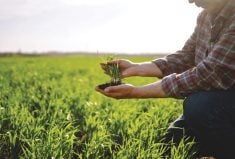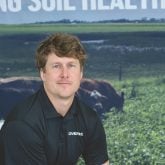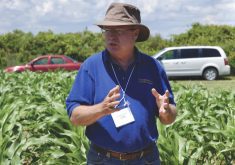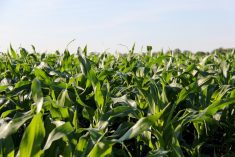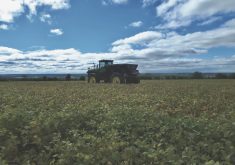In many ways, a soil test represents an aspect of farming that is necessary yet unfairly and inaccurately viewed with about as much anticipation as filing an income tax return. Despite the fact that soil tests provide invaluable information and a potential road map for adding value to future crop plans, there isn’t an overall welcome feel to the process or the results they provide.
Even with the current excitement over soil health, organic matter and cover crops, soil tests aren’t exactly greeted with a lot of fanfare.
Read Also

Producers aren’t panicking over tariffs and trade threats
The influence of tariff and trade uncertainity on farm business decisions.
Within the precision ag sphere of technology advances and utility, however, soil sampling is undergoing a substantial learning curve, particularly with the advent of a relatively new system that allows for accuracy, consistency and more detailed analysis.
Like many innovations and implements tied to precision ag, it isn’t the technology itself that’s necessarily new; it’s what a grower or the industry could eventually do with it.
The Wintex 3000 is the latest design upgrade in the Wintex system and its hallmark is its accuracy in soil sampling and data collection. Mounted on the side of an all terrain vehicle (ATV) or off the back of a pickup truck, it works in all soil types as well as in dry or compacted soils or even frozen soils, and it can gather three samples in one step.

What’s truly unique about this system is that it can sample to depths from zero to 90 centimetres (zero to 36 inches) and take samples at three different depths, if desired.
That it can do all of these things isn’t what makes it remarkable. It’s what the grower, their trusted adviser, researchers and the industry can do with that detail that is going to set it apart.
Ag Business and Crop, based near Palmerston, Ont., is the Canadian distributor for Wintex, and according to Brian Hall, agricultural solutions lead, there are applications to differentiate the use of the 3000 across different parts of Canada. The three-deep sampling, for one, has an appeal to researchers and agronomists in Western Canada who’ve been conducting research on soil fertility and soil properties at different levels for several years.
“They’ve been wanting to sample for nitrogen to this depth (from zero to 36 inches),” says Hall, adding that monitoring moisture levels in a drier climatic zone is another feature unique to the 3000 unit. “Another value would be for those wanting to examine differences in soil texture at different depths.”
Other uses beyond the farm include environmental monitoring of soil nitrates and phosphorus, particularly to a depth of 24 inches (60 cm). It’s a timely application for Ontario growers and the eastern Canadian agri-food industry as a whole, with the current focus on Great Lakes water quality initiatives. But these are just some of the more obvious uses, the low-hanging fruit, so to speak.
Start with accuracy
For Felix Weber, this latest design of the Wintex system represents greater accuracy in retrieving soil data, including GPS co-ordinates to better identify areas of a field, map them and determine the best course of action. In the West, the Ag Business and Crop chief executive officer says the Wintex 2000 two-depth sampler had been the most popular, but the 3000 has been quickly adopted as agronomists are doing deeper and sampling with an eye on monitoring nutrient and soil moisture levels.
“In the West, because of the moisture issue or the lack of moisture potential, root systems adjust to their environment,” adds Weber. “They sense the water and will go down deeper for what they need and recycle nutrients that are deeper in the profile if available. Roots are like the brains of the plant.”
Again, the idea of sampling from sub-soil levels may not be something new for a lot of farmers, but it’s the potential for that kind of detail that is differentiating the Wintex technology and opening the door on more applications. In Western Canada, Weber notes agronomists and researchers are more in tune with the detail provided by this technology. Since they’re dealing with limitations in soil moisture, they want to know more about the plant’s drive into deeper layers to access nutrients, particularly the mobile ones like nitrogen and sulphur.

The 3000 unit provides that “three-deep” — almost three-dimensional — look at the soil horizons in a field, and that can offer several different management options in a long-term cropping outlook. That’s where the possibilities and opportunities begin to take shape, adds Weber.
With a three-dimensional representation of a field, a grower can see the nutrients in the soil and also look at the texture and gauge the depths of the A and B and even the C horizon. It’s garnering information on different soil types and collecting information that runs more than just six inches deep.
The challenge, as with any technology, is how to take full advantage of it, which is where the industry sits today, trying to figure out how best to use the system and just how many “information doors” it can open. Some will use it for advanced core samples and to determine the depths of each soil profile, or they can look for compaction — without digging a soil pit.
“Imagine that while you take a sample, you can also measure compaction at the same time, and you know the GPS location,” poses Weber. “So we’re starting to add on more information to a soil sample that you wouldn’t do otherwise, and because it’s consistent across the field, it’s comparable year after year.”
This type of technology might also help livestock farmers with manure applications. Different soil types allow for different penetration rates, so it’s arguable that deep-profile sampling — and GPS mapping — could help reduce over-application of phosphorus via nutrient management.
This may help with best management practices (BMPs), environmental farm plans (EFPs) and nutrient management plans (NMPs), knowing the crop is cycling nutrients through that root zone nearest the plant. But it also shows how nutrients are cycling in the soil at deeper levels and how a crop may be drawing on reserves from those levels.
Changes in attitude
The potential uses are being examined and they are numerous. But Hall and Weber point out there are some imposing hurdles that still must be addressed.
Soil sampling is a less-desired job in the eyes of some advisers, and soil tests are regarded as a cost to be endured by farmers — and that really has to change. Weber speaks from experience when he used to gather samples as an Agri-Trend consultant.
Late-week forays into the field could be just one more job to get done, with the potential to lose focus and create more variability in sampling and the test results. The Wintex system removes that variability in taking the sample, creating confidence in its consistency while enhancing the productivity of the adviser.
“We’re talking about precision ag, where the importance is in the sampling,” says Weber. “If that sample is inconsistent, whatever the lab does afterwards isn’t going to be consistent either.”
It’s perhaps also a failing within the agri-business sector that more hasn’t been done to shift the mindset on soil testing so it’s perceived not as a cost but as an investment and a benchmark or a resource filled with valuable information.
The focus on efficiency
How farmers use that information can increase efficiency, make them better informed as to their cropping and management practices, and ultimately be more productive and profitable.
“Our field sizes have grown and then we went to different sampling systems with grid sampling, smart sampling and zone sampling,” says Hall. “But as those field sizes have grown, the tendency has been to amalgamate fields that have historically different practices on them but have we tracked those different fields when we’re sampling? We know that those can impact how those fields should be managed and the number of samples we collect.”
The fields where they collected four samples from 40 acres are now 100 to 200 acres or more. What an automatic soil sampler like the Wintex 3000 does is to allow them to cover those acres efficiently, to improve the accuracy of the samples, and to define management zones in the field.
“We have to get away from thinking in a negative way about what soil sampling means and change it to a positive and learn how we can make use of it,” says Weber.
“A lot of farmers do that already but I think it still can be stressed a bit. It’s not about just following the law, it’s about following good practices on my farm and making value out of what we have.”





